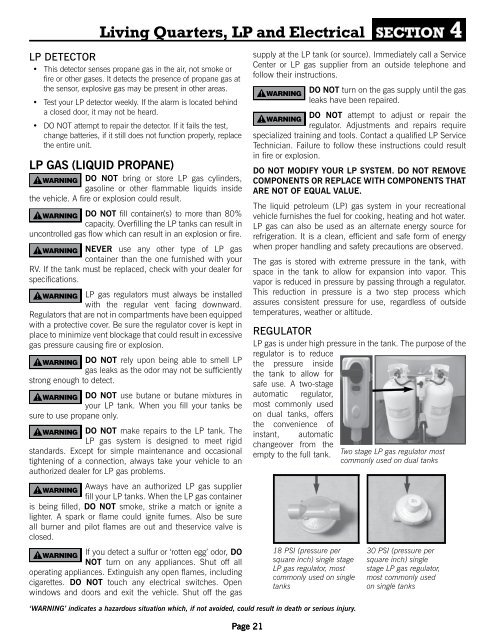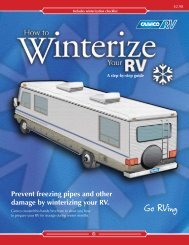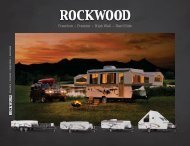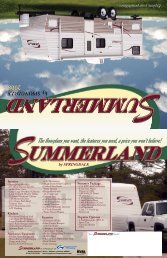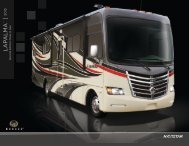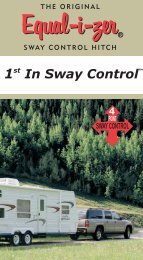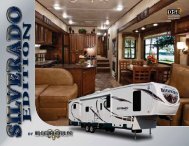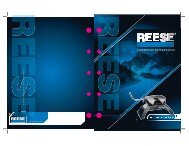Forest River Owners Manual - TTFW (PDF) - Pete's RV Center
Forest River Owners Manual - TTFW (PDF) - Pete's RV Center
Forest River Owners Manual - TTFW (PDF) - Pete's RV Center
You also want an ePaper? Increase the reach of your titles
YUMPU automatically turns print PDFs into web optimized ePapers that Google loves.
Living Quarters, LP and Electrical<br />
SECTION 4<br />
LP DETECTOR<br />
This detector senses propane gas in the air, not smoke or<br />
fire or other gases. It detects the presence of propane gas at<br />
the sensor, explosive gas may be present in other areas.<br />
Test your LP detector weekly. If the alarm is located behind<br />
a closed door, it may not be heard.<br />
DO NOT attempt to repair the detector. If it fails the test,<br />
change batteries, if it still does not function properly, replace<br />
the entire unit.<br />
LP GAS (LIQUID PROPANE)<br />
WARNING DO NOT bring or store LP gas cylinders,<br />
gasoline or other flammable liquids inside<br />
the vehicle. A fire or explosion could result.<br />
WARNING DO NOT fill container(s) to more than 80%<br />
capacity. Overfilling the LP tanks can result in<br />
uncontrolled gas flow which can result in an explosion or fire.<br />
WARNING NEVER use any other type of LP gas<br />
container than the one furnished with your<br />
<strong>RV</strong>. If the tank must be replaced, check with your dealer for<br />
specifications.<br />
WARNING LP gas regulators must always be installed<br />
with the regular vent facing downward.<br />
Regulators that are not in compartments have been equipped<br />
with a protective cover. Be sure the regulator cover is kept in<br />
place to minimize vent blockage that could result in excessive<br />
gas pressure causing fire or explosion.<br />
WARNING DO NOT rely upon being able to smell LP<br />
gas leaks as the odor may not be sufficiently<br />
strong enough to detect.<br />
WARNING DO NOT use butane or butane mixtures in<br />
your LP tank. When you fill your tanks be<br />
sure to use propane only.<br />
WARNING DO NOT make repairs to the LP tank. The<br />
LP gas system is designed to meet rigid<br />
standards. Except for simple maintenance and occasional<br />
tightening of a connection, always take your vehicle to an<br />
authorized dealer for LP gas problems.<br />
Aways have an authorized LP gas supplier<br />
WARNING<br />
fill your LP tanks. When the LP gas container<br />
is being filled, DO NOT smoke, strike a match or ignite a<br />
lighter. A spark or flame could ignite fumes. Also be sure<br />
all burner and pilot flames are out and theservice valve is<br />
closed.<br />
WARNING If you detect a sulfur or ‘rotten egg’ odor, DO<br />
NOT turn on any appliances. Shut off all<br />
operating appliances. Extinguish any open flames, including<br />
cigarettes. DO NOT touch any electrical switches. Open<br />
windows and doors and exit the vehicle. Shut off the gas<br />
supply at the LP tank (or source). Immediately call a Service<br />
<strong>Center</strong> or LP gas supplier from an outside telephone and<br />
follow their instructions.<br />
WARNING<br />
DO NOT turn on the gas supply until the gas<br />
leaks have been repaired.<br />
DO NOT attempt to adjust or repair the<br />
WARNING<br />
regulator. Adjustments and repairs require<br />
specialized training and tools. Contact a qualified LP Service<br />
Technician. Failure to follow these instructions could result<br />
in fire or explosion.<br />
DO NOT MODIFY YOUR LP SYSTEM. DO NOT REMOVE<br />
COMPONENTS OR REPLACE WITH COMPONENTS THAT<br />
ARE NOT OF EQUAL VALUE.<br />
The liquid petroleum (LP) gas system in your recreational<br />
vehicle furnishes the fuel for cooking, heating and hot water.<br />
LP gas can also be used as an alternate energy source for<br />
refrigeration. It is a clean, efficient and safe form of energy<br />
when proper handling and safety precautions are observed.<br />
The gas is stored with extreme pressure in the tank, with<br />
space in the tank to allow for expansion into vapor. This<br />
vapor is reduced in pressure by passing through a regulator.<br />
This reduction in pressure is a two step process which<br />
assures consistent pressure for use, regardless of outside<br />
temperatures, weather or altitude.<br />
REGULATOR<br />
LP gas is under high pressure in the tank. The purpose of the<br />
regulator is to reduce<br />
the pressure inside<br />
the tank to allow for<br />
safe use. A two-stage<br />
automatic regulator,<br />
most commonly used<br />
on dual tanks, offers<br />
the convenience of<br />
instant, automatic<br />
changeover from the<br />
empty to the full tank.<br />
18 PSI (pressure per<br />
square inch) single stage<br />
LP gas regulator, most<br />
commonly used on single<br />
tanks<br />
Two stage LP gas regulator most<br />
commonly used on dual tanks<br />
30 PSI (pressure per<br />
square inch) single<br />
stage LP gas regulator,<br />
most commonly used<br />
on single tanks<br />
‘WARNING’ indicates a hazardous situation which, if not avoided, could result in death or serious injury.<br />
Page 21


